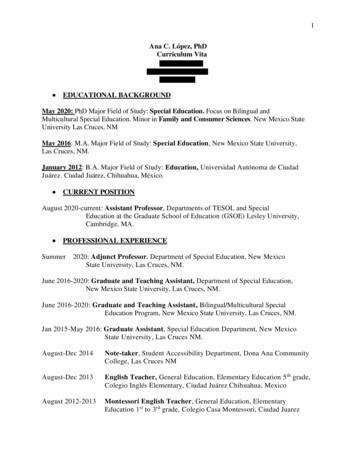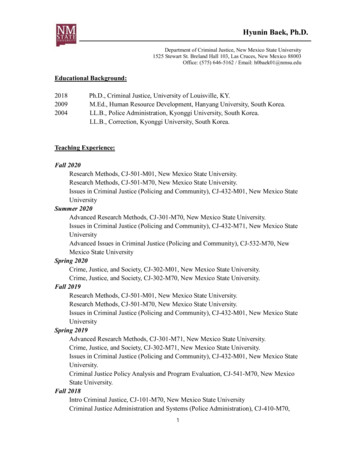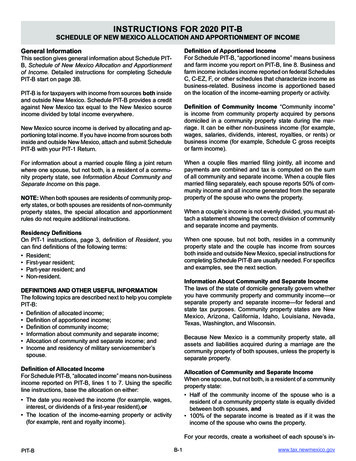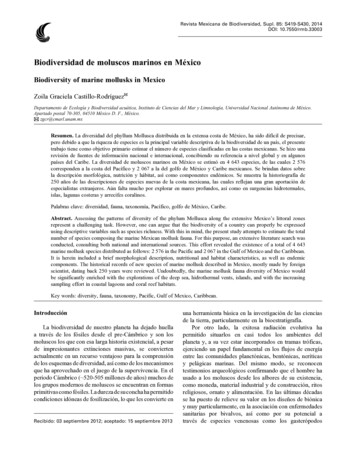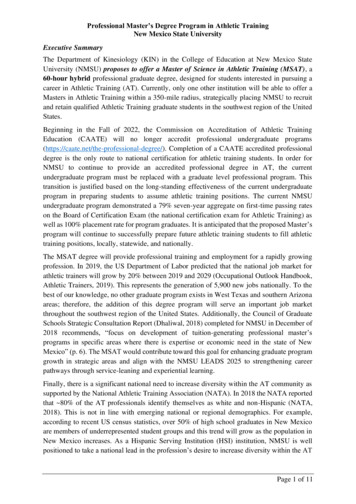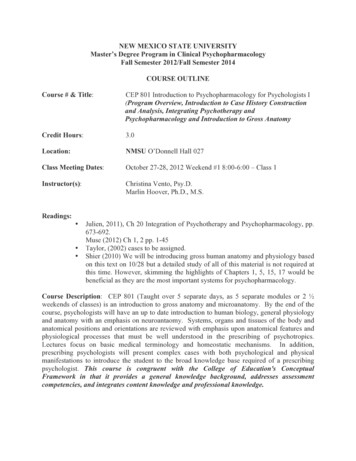
Transcription
NEW MEXICO STATE UNIVERSITYMaster’s Degree Program in Clinical PsychopharmacologyFall Semester 2012/Fall Semester 2014COURSE OUTLINECourse # & Title:CEP 801 Introduction to Psychopharmacology for Psychologists I(Program Overview, Introduction to Case History Constructionand Analysis, Integrating Psychotherapy andPsychopharmacology and Introduction to Gross AnatomyCredit Hours:3.0Location:NMSU O’Donnell Hall 027Class Meeting Dates:October 27-28, 2012 Weekend #1 8:00-6:00 – Class 1Instructor(s):Christina Vento, Psy.D.Marlin Hoover, Ph.D., M.S.Readings: Julien, 2011), Ch 20 Integration of Psychotherapy and Psychopharmacology, pp.673-692.Muse (2012) Ch 1, 2 pp. 1-45Taylor, (2002) cases to be assigned.Shier (2010) We will be introducing gross human anatomy and physiology basedon this text on 10/28 but a detailed study of all of this material is not required atthis time. However, skimming the highlights of Chapters 1, 5, 15, 17 would bebeneficial as they are the most important systems for psychopharmacology.Course Description: CEP 801 (Taught over 5 separate days, as 5 separate modules or 2 ½weekends of classes) is an introduction to gross anatomy and microanatomy. By the end of thecourse, psychologists will have an up to date introduction to human biology, general physiologyand anatomy with an emphasis on neuroantaomy. Systems, organs and tissues of the body andanatomical positions and orientations are reviewed with emphasis upon anatomical features andphysiological processes that must be well understood in the prescribing of psychotropics.Lectures focus on basic medical terminology and homeostatic mechanisms. In addition,prescribing psychologists will present complex cases with both psychological and physicalmanifestations to introduce the student to the broad knowledge base required of a prescribingpsychologist. This course is congruent with the College of Education's ConceptualFramework in that it provides a general knowledge background, addresses assessmentcompetencies, and integrates content knowledge and professional knowledge.
Objectives: Students will:1. Understand the complexity of issues involved in determining appropriatepsychotropic intervention.2. Will have a new appreciation for how patient’s underlying medical conditions mustbe considered in the use of medications.3. Begin to learn how side effects of certain medications can actually assist in bothpsychological and medical symptomology.4. Understand and be able to communicate using appropriate medical terminology fororgan parts and positions.5. Review and increase understanding of morphology on the cellular, tissue and grosslevels.6. Be able to explicate homeostatic mechanisms involved in each system.Evaluation: There will be a test (multiple choice, short answer or true/false) which will begiven at the end of each weekend. The answers will be reviewed in class. Students’ experientialcase studies will be graded on pass/fail with the expectation for a demonstration of a high levelcompetence of the biopsychosocial model of care. The grades on the standardized tests willconstitute two-thirds of the grade and the grade on the case studies one-third of the grade foreach course.GradingAssignmentsTests (5 @ 12 pts ea, 90% 12 pts, 80% 11 pts, 70% 10 pts)Experiential case studies (30 pts)Points Possible60 pts.30 pts.Course grades70 pts total “A” course grade60 pts total “B” course grade50 pts total “C” course gradeStudents with Disabilities: If you have or believe you have a disability, you may wish to selfidentify. You can do so by providing documentation to the Office for Services for Studentswith Disabilities, located at Garcia Annex (telephone: 646-6840). Appropriateaccommodations may then be provided for you. If you have a condition which may affect yourability to exit from the premises in an emergency or which may cause an emergency duringclass, you are encouraged to discuss this in confidence with the instructor and/or the directorof Disabled Student Programs. If you have questions about the Americans with DisabilitiesAct (ADA), call 646-3635.
SIAP/NEW MEXICO STATE UNIVERSITYMaster’s Degree Program in Clinical PsychopharmacologyCOURSE OUTLINECourse # & Title:CEP 801 Introduction to Psychopharmacology for Psychologists I(Introduction to Gross Neuroanatomy and Chemical Anatomy ofthe Nervous System)Credit Hours:3.0Location:OH 027Class Meeting Dates:November 16-17, 2012– Class 2Instructor(s):Tony Kreuch, Psy.D.Readings: Stahl, (2008), On the Brain and Neuropathways, pgs 195-245. (this is toughreading, but please take a first try)Stern & Herman, (2003), pgs 265-267Brain Dissection Manual given in classGoldberg (2207) Clinical Neuroanatomy pp. 1-85McCance, (2009) Ch. 14 ppg. 416-432 Course Description: The part of CEP 801 is a thorough study of gross, micro and anatomy ofthe brain. The structural anatomy of the cerebral cortex, subcortex will be discussed in regardsto the ways in which these structures interact with psychopharmacological agents. Special focuswill be given to the structural aspects of the frontal cortex, hippocampus, basal ganglia, thalamusand hypothalamus with particular attention to the locus coerulus, dorsal raphe nuclei and thenucleus accumbens. This course is congruent with the College of Education's ConceptualFramework in that it provides a general knowledge background, addresses assessmentcompetencies, and integrates content knowledge and professional knowledge.Objectives: Students will:1.2.3.4.Learn to identify the major structures of the brain.Learn the central functions of the major brain structures.Gain an understanding of how these brain structures interact.Learn how directionality terminology (such as prefrontal cortex) relate to internalfunctions.5. Be able to point to the frontal cortex, hippocampus, amygdale, basal ganglia, thalamusand hypothalamus, locus coerulus, dorsal raphe nuclei, other relevant nuclei and nucleusaccumbens.6. Be able to compare the various areas of the sheep brain (cerebrum, brain stem, andcerebellum) to the human brain.
7. Be able to trace the blood supply of the brain.8. Be able to trace the ventricles.Evaluation: There will be a test (multiple choice, short answer or true/false) which will begiven at the end of each weekend. The answers will be reviewed in class. Students’ experientialcase studies will be graded on pass/fail with the expectation for a demonstration of a high levelcompetence of the biopsychosocial model of care. The grades on the standardized tests willconstitute two-thirds of the grade and the grade on the case studies one-third of the grade foreach course.GradingAssignmentsTests (5 @ 12 pts ea, 90% 12 pts, 80% 11 pts, 70% 10 pts)Experiential case studies (30 pts)Points Possible60 pts.30 pts.Course grades70 pts total “A” course grade60 pts total “B” course grade50 pts total “C” course gradeStudents with Disabilities: If you have or believe you have a disability, you may wish to selfidentify. You can do so by providing documentation to the Office for Services for Studentswith Disabilities, located at Garcia Annex (telephone: 646-6840). Appropriateaccommodations may then be provided for you. If you have a condition which may affect yourability to exit from the premises in an emergency or which may cause an emergency duringclass, you are encouraged to discuss this in confidence with the instructor and/or the directorof Disabled Student Programs. If you have questions about the Americans with DisabilitiesAct (ADA), call 646-3635.
SIAP/NEW MEXICO STATE UNIVERSITYMaster’s Degree Program in Clinical PsychopharmacologyCOURSE OUTLINECourse # & Title:CEP 801 Introduction to Psychopharmacology for Psychologists I(Introduction to Neuroanatomy and Chemical Anatomy of theNervous System)Credit Hours:3.0Location:Live and onlineClass Meeting Dates:December 15-16, 2012– Class 3Instructor(s):Mitchell Simson, M.D.Readings: Goldberg, (2007), Clinical Neuroanatomy Made Ridiculously Simple, pgs 1 – 97Julien (2011) A Primer of Drug Action, pgs. 60-89Stahl (2008) Stahl’s Essential Psychopharmacology: Neuroscientific Basis andPractical Applications, Ch 1-5 pgs. 1-123Muse and Moore (2012) Handbook of Clinical Psychopharmacology forPsychologists pp. 45-106.Course Description: Today’s class completes the overview of gross, micro and chemicalanatomy of the nervous system. The structural anatomy of the cerebral cortex, sub cortex,brainstem, spinal cord and autonomic nervous system will also be discussed in regards to theways in which these structures interact with psychopharmacological agents. Special focus will begiven to the structural aspects of the frontal cortex, hippocampus, basal ganglia, thalamus andhypothalamus with particular attention to the locus coerulus, dorsal raphe nuclei and the nucleusaccumbens. The function of neurotransmitter systems will be categorized according to thepharmacological agents which affect them and according to the ways in which they interact witha variety of anatomical pathways. This course is congruent with the College of Education'sConceptual Framework in that it provides a general knowledge background, addressesassessment competencies, and integrates content knowledge and professional knowledge.Objectives: Students will:1. Be able to locate and trace the brain stem and examine the spinal column.2. Be able to locate the cranial nerves and their attachment location.3. Be able to identify the anatomical features and trace the neuronal pathways associatedwith anxiety disorders, depression, cognitive decline, substance abuse andschizophrenia.4. Develop extensive knowledge of normal neuronal functioning.
5. Learn the localization and functions of different neurotransmitter systems in thecentral and peripheral nervous systems.6. Learn neuromorphology on the cellular and central nervous system levels.Evaluation: There will be a test (multiple choice, short answer or true/false) which will begiven at the end of each class. The answers will be reviewed in class. Students’ experientialcase studies will be graded on pass/fail with the expectation for a demonstration of a high levelcompetence of the biopsychosocial model of care. The grades on the standardized tests willconstitute two-thirds of the grade and the grade on the case studies one-third of the grade foreach course.GradingAssignmentsTests (5 @ 12 pts ea, 90% 12 pts, 80% 11 pts, 70% 10 pts)Experiential case studies (30 pts)Points Possible60 pts.30 pts.Course grades70 pts total “A” course grade60 pts total “B” course grade50 pts total “C” course gradeStudents with Disabilities: If you have or believe you have a disability, you may wish to selfidentify. You can do so by providing documentation to the Office for Services for Studentswith Disabilities, located at Garcia Annex (telephone: 646-6840). Appropriateaccommodations may then be provided for you. If you have a condition which may affect yourability to exit from the premises in an emergency or which may cause an emergency duringclass, you are encouraged to discuss this in confidence with the instructor and/or the directorof Disabled Student Programs. If you have questions about the Americans with DisabilitiesAct (ADA), call 646-3635.
SIAP/NEW MEXICO STATE UNIVERSITYMaster’s Degree Program in Clinical PsychopharmacologyCOURSE OUTLINECourse # & Title:CEP 802 Introduction to Chemistry and Biochemistryfor the Prescribing PsychologistCredit Hours:3.0Location:Live and onlineClass Meeting Dates:January 12-13 2013– Class 4Instructor(s):Kevin McGuinness, Ph.D. M.S.Required Text(s):Goldberg, S, (2010), Biochemistry, pgs 1 - 50Readings:Chemical Basis of Life p 50-74; review Cells p 75-113;Course Description: CEP 802 provides students with a review of those aspects of chemistry,organic chemistry and biochemistry which are needed for the study of pharmacology. In generalchemistry, the concepts of chemical compounds and bonds, and atomic theory will be reviewed.In organic chemistry, the concepts of organic compounds, bonds and valences will be reviewed.In biochemistry, biomolecules of proteins, carbohydrates, nucleic acids and lipids, as well aschromosomal theory and the genetic code, enzymes and metabolism will be covered. Thiscourse will review and update student’s understanding of critical principles in biochemistry,including: chemical compounds and bonds (covalent, ionic, hydrophilic/hydrophobic, hydrogenbonds); atomic theory; organic compounds, bonds and valences; biomolecules (proteins,carbohydrates, nucleic acids and lipids); enzymes and metabolism; transport processes inneurons; and biochemical mechanisms of neuronal signaling.Objectives: Students will become familiar with 1.2.3.4.5.Atomic theoryTypes of chemical bonds (covalent, ionic, hydrophilic/hydrophobic, hydrogen bonds)The nature of organic compounds, bonds and valencesThe formulation of biomolecules (proteins, carbohydrates, nucleic acids and lipids)The formulation of enzymes and metabolismEvaluation: There will be a test (multiple choice, short answer or true/false) which will begiven at the end of each class. The answers will be reviewed in class. Students’ experientialcase studies will be graded on pass/fail with the expectation for a demonstration of a high levelcompetence of the biopsychosocial model of care. The grades on the standardized tests willconstitute two-thirds of the grade and the grade on the case studies one-third of the grade foreach course.
GradingAssignmentsTests (5 @ 12 pts ea, 90% 12 pts, 80% 11 pts, 70% 10 pts)Experiential case studies (30 pts)Points Possible60 pts.30 pts.Course grades70 pts total “A” course grade60 pts total “B” course grade50 pts total “C” course gradeStudents with Disabilities: If you have or believe you have a disability, you may wish to selfidentify. You can do so by providing documentation to the Office for Services for Studentswith Disabilities, located at Garcia Annex (telephone: 646-6840). Appropriateaccommodations may then be provided for you. If you have a condition which may affect yourability to exit from the premises in an emergency or which may cause an emergency duringclass, you are encouraged to discuss this in confidence with the instructor and/or the directorof Disabled Student Programs. If you have questions about the Americans with DisabilitiesAct (ADA), call 646-3635.
SIAP/NEW MEXICO STATE UNIVERSITYMaster’s Degree Program in Clinical PsychopharmacologyCOURSE OUTLINECourse # & Title:CEP 802 Overview of Human Drug Groups for TreatmentCredit Hours:3.0Location:O’Donnell Hall Room 027Class Meeting Dates:February 16-17, 2013– Class 5Instructor(s):Wanda Borges, Ph.D.Class Meeting Times:8:00 AM – 5:00 PM, 8:00AM-3:00PMRequired Text(s):Shier D., Butler J., and Lewis R., Hole’s Human Anatomy &Physiology, 12th Ed. McGraw Hill (2010).Arcangelo, V. & Peterson, A. (2011). Pharmacotherapeutics forAdvanced Practice: A Practical Approach, 3rd Ed.J. Olson 2011 Pharmacology Made Ridiculously SimpleReadings:Course Description: Today’s class will review the major therapeutic drug groups used to treathuman disease.Topics covered will include introduction to pharmacodynamics andpharmacokinetics, major drugs for skin, ear, eye, cardiovascular, respiratory, neurological,immunological, endocrine, OB/GYN, GI and GU disorders. Special issues related tomedications in the elderly and in pediatric populations as well as integrative health care andhealth promotion will also be addressedThis course is congruent with the College of Education's Conceptual Framework in that itprovides a general knowledge background, addresses assessment competencies, and integratescontent knowledge and professional knowledge.Objectives: Students will learn:1. Overview of the major drug groups used to treat human disease2. To use case based learning to understand how drugs work in the human body totreat diseaseEvaluation: There will be a test (multiple choice, short answer or true/false) which will begiven at the end of each weekend. The answers will be reviewed in class. Students’ experientialcase studies will be graded on pass/fail with the expectation for a demonstration of a high levelcompetence of the biopsychosocial model of care. The grades on the standardized tests willconstitute two-thirds of the grade and the grade on the case studies one-third of the grade foreach course.
GradingAssignmentsTests (5 @ 12 pts ea, 90% 12 pts, 80% 11 pts, 70% 10 pts)Experiential case studies (30 pts)Points Possible60 pts.30 pts.Course grades70 pts total “A” course grade60 pts total “B” course grade50 pts total “C” course gradeStudents with Disabilities: If you have or believe you have a disability, you may wish to selfidentify. You can do so by providing documentation to the Office for Services for Studentswith Disabilities, located at Garcia Annex (telephone: 646-6840). Appropriateaccommodations may then be provided for you. If you have a condition which may affect yourability to exit from the premises in an emergency or which may cause an emergency duringclass, you are encouraged to discuss this in confidence with the instructor and/or the directorof Disabled Student Programs. If you have questions about the Americans with DisabilitiesAct (ADA), call 646-3635.
SIAP/NEW MEXICO STATE UNIVERSITYMaster’s Degree Program in Clinical PsychopharmacologyCOURSE OUTLINECourse # & Title:CEP 803 Principles of Pharmacology ICredit Hours:3.0Location:Live and onlineClass Meeting Dates:March 16-17, 2013-Class 6Instructor(s):Joseph Masserano, Ph.D.Readings: Olsen, (2011), pgs 1-13Julien, (2008), pgs 1-59McGrath & Moore, (2010), pgs 133-150 on drug researchStern & Herman, (2003), pgs 375-395Arcangelo, V. & Peterson, A. (2011). Pharmacotherapeutics for AdvancedPractice: A Practical Approach, 3rd Ed. Ch. 1-2Course Description CEP 803 covers the principles of drug action that sets the stage for allfurther discussion of drug action and drug use in the treatment of mental disorders. Themechanisms of pharmacokinetics and pharmacodynamics determine the properties thatcharacterize all drugs, such as route of administration, dosage and dosing interval. Objectivesinclude understanding the central role in drug metabolism of the cytochrome P450 enzymesystem; how pH and pKa determine the distribution of drugs across biological membranes; drug:drug interactions at the pharmacokinetic level, and drug excretion. This course is congruentwith the College of Education's Conceptual Framework in that it provides a generalknowledge background, addresses assessment competencies, and integrates content knowledgeand professional knowledge.Objectives: Students will:1. Learn the principles of pharmacokinetics: absorption, distribution, metabolism, andexcretions as they apply to understanding how psychotropic medications work.2. Learn the basic principles of pharmacodynamics as they apply to understanding howpsychotropic medications work.3. Know the central role in drug metabolism of the cytochrome P450 enzyme system as theyapply to understanding how psychotropic medications work.4. Understand how pH and pKa determine the distribution of drugs across biologicalmembranes as they apply to understanding how psychotropic medications work.
Evaluation: There will be a test (multiple choice, short answer or true/false) which will begiven at the end of each day.Note: Due to a scheduling conflict, Dr. Masserano pre-recorded his lecture and it will be playedand reviewed with Dr. Vento, NMSU/SIAP Training Director to answer questions during thescheduled class session.GradingAssignmentsTests (5 @ 12 pts ea, 90% 12 pts, 80% 11 pts, 70% 10 pts)Experiential case studies (30 pts)Points Possible60 pts.30 pts.Course grades70 pts total “A” course grade60 pts total “B” course grade50 pts total “C” course gradeStudents with Disabilities: If you have or believe you have a disability, you may wish to selfidentify. You can do so by providing documentation to the Office for Services for Studentswith Disabilities, located at Garcia Annex (telephone: 646-6840). Appropriateaccommodations may then be provided for you. If you have a condition which may affect yourability to exit from the premises in an emergency or which may cause an emergency duringclass, you are encouraged to discuss this in confidence with the instructor and/or the directorof Disabled Student Programs. If you have questions about the Americans with DisabilitiesAct (ADA), call 646-3635.
SIAP/NEW MEXICO STATE UNIVERSITYMaster’s Degree Program in Clinical PsychopharmacologyCOURSE OUTLINECourse # & Title:CEP 803 Principles of Pharmacology IICredit Hours:3.0Location:Live and onlineClass Meeting Dates:April 13-14, 2013– Class 7Instructor(s):Joseph Masserano, Ph.D.Readings: Olsen, (2011), pgs 1-13Julien, (2008), pgs 1-59McGrath & Moore, (2010), pgs 133-150 on drug researchStern & Herman, (2003), pgs 375-395Arcangelo & Peterson (2011) pp. 30-49Course Description This advanced section of CEP 803 focuses upon pharmacodynamics, thestudy of the underlying mechanisms by which drugs exert their effects on the body, includingdrug effects on physiological systems as well as the molecular mechanisms of drug action. Thisstudy revolves around the mechanisms of drug: receptor interactions. Objectives includeunderstanding the physiological and biochemical mechanisms of drug action; being able to usebasic principles, including drug half-lives, to plan and revise dosages and dosing schedules anddose-response relationships. This course is congruent with the College of Education'sConceptual Framework in that it provides a general knowledge background, addressesassessment competencies, and integrates content knowledge and professional knowledge.Objectives: Students will:1. Understand the physiological and biochemical mechanisms of drug action.2. Be able to use basic principles, including drug half-lives, to plan and revise dosages anddosing schedules.Evaluation: There will be a test (multiple choice, short answer or true/false) which will begiven at the end of the class. The answers will be reviewed in class.Students with Disabilities: If you have or believe you have a disability, you may wish to selfidentify. You can do so by providing documentation to the Office for Services for Studentswith Disabilities, located at Garcia Annex (telephone: 646-6840). Appropriateaccommodations may then be provided for you. If you have a condition which may affect yourability to exit from the premises in an emergency or which may cause an emergency during
class, you are encouraged to discuss this in confidence with the instructor and/or the directorof Disabled Student Programs. If you have questions about the Americans with DisabilitiesAct (ADA), call 646-3635.
SIAP/NEW MEXICO STATE UNIVERSITYMaster’s Degree Program in Clinical PsychopharmacologyCOURSE OUTLINEPathophysiology Weekend #1Course # & Title:CEP 806 Physical Assessment – Review of Systems and theEvaluation of Systems with Demonstrations of Normal andAbnormal Findings, Special Consideration of the SkinCredit Hours:3.0 Credit HoursLocation:Live and onlineClass Meeting Date:May 18-19 2013– Class 8Instructor(s):Mitchell Simson, M.D.Marlin Hoover, Ph.D., M.S.Family Practice Residency StaffChristina Vento, Psy.D.Required Text(s): Bickley, L.S., (2009), pgs 65-66, 102-281 and video McCance, K.L., & Huether, S.E., (2009), pgs 43-93, 1644-1680Watch: Video demonstration of a physical examProgram Overview: The program will begin with an orientation and overview of the didacticand practicum components required for graduation. Throughout the ten didactic courses thatmake up the Master’s Degree Program students will have opportunities to apply principleslearned to clinical cases through experiential assignments that increase in complexity as thestudents’ knowledge of psychopharmacology and the biopsychosocial model becomes moresophisticated. Some of these experiential assignments will be based upon students’ existingpatient populations. Others will involve role-playing activities in classes. Still others willinvolve the observation of actual clinical protocols. Students will be given written exercisesbased upon these experiences that will be compiled into a clinical notebook of clinical basedstudies. These assignments will be averaged with the students’ scores on objective tests todetermine their grades for each class.Course Description This class focuses on overall physical assessment. Methods of medicalhistory taking including documentation of pertinent medical history, medications and drugallergies, chief medical complaint, determination of vital signs and basics of the physical examwill be covered. Students will then focus upon a physical examination of the skin.
Equipment:StethoscopeBlood Pressure CuffReflex HammerTuning ForkOther equipment needed to conduct physical examinations will be providedObjectives:Students will:1. Learn the basic philosophy and physical techniques of conducting physical examinations.2. Exhibit proficiency in the following:a. establishing appropriate doctor-patient relationships in conducting physical examsand demonstrating the respect for patient privacyb. using standard precautions in infection controlc. taking and recording temperature, height, weight, and blood pressuresd. taking patient and family history3. Develop basic familiarity with techniques (such as inspection, palpation, percussion,auscultation) used in conducting physical examinations (proficiency in examiningdifferent systems will be developed in later courses)Evaluation: There will be a test (multiple choice, short answer or true/false) which will begiven to students before class. Students should come to class with the test completed and theanswers will be reviewed in class. Case studies will be presented that involve dual diagnosesmedical and psychological problems. Students will be expected to write up one case in a SOAPformat. Students’ experiential case studies will be graded on pass/fail with the expectation for ademonstration of a high level competence of the biopsychosocial model of care. The grades onthe standardized tests will constitute two-thirds of the grade and the grade on the case studiesone-third of the grade for each course.GradingAssignmentsTests (5 @ 12 pts ea, 90% 12 pts, 80% 11 pts, 70% 10 pts)Experiential case studies (30 pts)Points Possible60 pts.30 pts.Course grades70 pts total “A” course grade60 pts total “B” course grade50 pts total “C” course gradeStudents with Disabilities: If you have or believe you have a disability, you may wish to selfidentify. You can do so by providing documentation to the Office for Services for Studentswith Disabilities, located at Garcia Annex (telephone: 646-6840). Appropriateaccommodations may then be provided for you. If you have a condition which may affect yourability to exit from the premises in an emergency or which may cause an emergency duringclass, you are encouraged to discuss this in confidence with the instructor and/or the directorof Disabled Student Programs. If you have questions about the Americans with DisabilitiesAct (ADA), call 646-3635.
SIAP/NEW MEXICO STATE UNIVERSITYMaster’s Degree Program in Clinical PsychopharmacologyCOURSE OUTLINEPathophysiology Weekend #2Course # & Title:CEP 806 - Pathophysiology and Physical Assessment of theImmune SystemCredit Hours:3.0 Credit HoursLocation:Live and onlineClass Meeting Date:June 8-9, 2013– Class 9Instructor(s):Mitchell Simson, M.D.Marlin Hoover, Ph.D., M.S.Family Practice Residency StaffChristina Vento, Psy.D.Required Text(s): McCance, K.L., & Huether, S.E., (2009) pgs 183-289, basicsPgs 290-430, read for familiarity Olsen, (2011), pgs 133-142, anti-inflammatory drugsPgs 97-121, anti-infectionPgs 121-133, anti-cancerProgram Overview: The program will begin with an orientation and overview of the didacticand practicum components required for graduation. Throughout the ten didactic courses thatmake up the Master’s Degree Program students will have opportunities to apply principleslearned to clinical cases through experiential assignments that increase in complexity as thestudents’ knowledge of psychopharmacology and the biopsychosocial model becomes moresophisticated. Some of these experiential assignments will be based upon students’ existingpatient populations. Others will involve role-playing activities in classes. Still others willinvolve the observation of actual clinical protocols. Students will be given written exercisesbased upon these experiences that will be compiled into a clinical notebook of clinical basedstudies. These assignments will be averaged with the students’ scores on objective tests todetermine their grades for each class.Course Description: The physical assessment and pathophysiology of the immune system arestudied in depth. Immune function and psychoimmunology are reviewed.
Equipment:StethoscopeBlood Pressure CuffObjectives: Students cribe the pathophysiological mechanisms and relevant assessment findings in theimmune system.Discuss the pathophysiological basis of common abnormal assessment findings in theimmune system.Interpret assessment findings for the immune system logically based on anunderstanding of pathophysiological mechanisms.Learn the most common laboratory tests which indicate normal and abnormalimmune functioning.Apply analytic reasoning and problem solving to a variety of selected clinical casesituations of the immune system.Interpret normal from abnormal in both anticipated and actual findings in thecomprehensive health assessment of the immune system.Synthesize assessment findings of the immune system into diagnoses using adeliberate and systematic process of data collection and analysis.Explain how symptoms of allergies as well as medications to treat allergies can affecta patient’s overall psychological functioning.Describe th
Master's Degree Program in Clinical Psychopharmacology Fall Semester 2012/Fall Semester 2014 COURSE OUTLINE . Psychopharmacology and Introduction to Gross Anatomy Credit Hours: 3.0 Location: NMSU O'Donnell Hall 027 Class Meeting Dates: October 27-28, 2012 Weekend #1 8:00-6:00 - Class 1 Instructor(s): Christina Vento, Psy.D.



